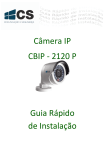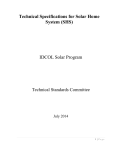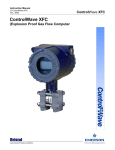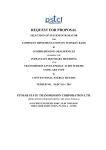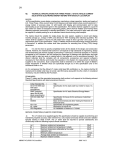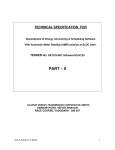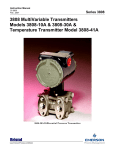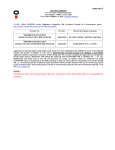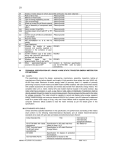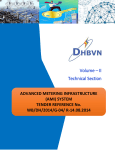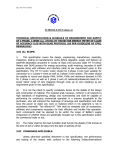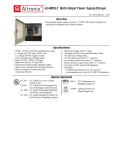Download - NPCIL e
Transcript
TECHNICAL SPECIFICATION FOR SINGLE PHASE LT STATIC WHOLE CURRENT SOLID STATE ELECTRONIC ENERGY METERS WITH BACKLIT LCD DISPLAY 1.0 SCOPE: This specification covers design; manufacture, Supply & installation in various houses of TMS township of LT single phase static energy meters 10-60A with LCD display & optical port for LPRF along with CMRI, supporting hardware and software for import/export data in soft facilitate to print text reports as per technical specification. 2.0 STANDARDS: These LT meters and the associated accessories shall conform in all respects to the following Relevant Standard Specifications with latest amendment there to:Indian Standard No. IS:13779-1999 read with latest amendments CBIP Technical report No.88 (with latest amendments) 3.0 Title Specification for AC static watt hour meter for class 1&2 Specification for AC static Electrical Energy Meters. IS:9000 Basic environmental and Electronic & Electrical items. other IS:11731 IS: 11000 Specification for engineering plastic. Resistance to heat & fire Testing for SERVICE CONDITIONS (CLIMATIC CONDITIONS): The meters to be supplied against this specification should be capable of performing and maintaining required accuracy under extreme hot, cold, tropical and dusty climate and solar radiation typically existing in State of Maharashtra. The meter shall be required to operate satisfactorily and continuously under the following tropical climatic conditions: Maximum ambient air temperature Maximum ambient air temperature in shade Maximum temperature attainable by the meter exposed to sun Minimum ambient temperature Average daily ambient air temperature 550C 450C 60 0C Maximum relative humidity Number of month of tropical monsoon condition Maximum altitude above mean sea level Average annual rain fall Maximum wind pressure Isokeraunic level Seismic level (horizontal accn.) Permitted noise level 95% 4 months (-) 50C 400C 1000 meters 150 cm 200 kg/sq. m 40 days per year 0.30 g 45db All the parts & surface, which are subject to corrosion shall either be made of such material or shall be provided with such protective covering and finish, which ensures total protection from any injurious effect of humidity. 4.0 PRINCIPAL PARAMETERS: These meters shall conform to the following specific parameters: Item Specification Type of installation Indoor System voltage (phase to neutral) 240V + 20% to 40% neutral solidly grounded. System frequency 50 Hz ±5% No. of phases 1 phase 2 wire (single Phase +Neutral) System earthing Solidly grounded Resistance to surge voltage of 1.5/50 As per relevant IS Micro sec. Test voltage at 50 Hz 4KV RMS for 1 minute including latest amendments in relevant IS. 5.0 RATINGS: The meters as specified in scope of this tender shall be rated as follows: Voltage Current Basic current (Ib) Rated max. Continuous current (Imax) Frequency Accuracy 6.0 240V 10A 60A 50Hz Class 1.0 POWER SUPPLY VARIATION: The extreme power supply variations which the meter should withstand without damage and without degradation of its metering characteristics, as it operates under its normal operating Conditions would be as under: Voltage Current Frequency PF range +20% to 40% of rated voltage 120% of Imax. ± 5% of rated frequency Zero (lag) unity Zero (lead) The meter shall work over wide PF range and the limits of errors with the variation of PF shall be as per CBIP 88 (latest amendments)/IS: 13779 7.0 POWER CONSUMPTION: 7.1 VOLTAGE CIRCUIT: The active and apparent power consumption in voltage circuit including power supply of meter at reference voltage, reference temperature and reference frequency shall not exceed 1.5 Watts and 8 VA respectively as per IS:13779. 7.2 CURRENT CIRCUIT: The apparent power taken by current circuit at basic current, reference frequency and reference temperature shall not exceed 4 VA as per IS: 13779. 7.3 AUXILIARY POWER: The meter shall draw power for working of electronic circuit from phase & neutral. 8.0 STARTING CURRENT: The meter should start registering energy at 0.4% of basic current at UPF as per IS: 13779. 9.0 RUNNING WITH NO LOAD: When 115% of rated voltage is applied with no current flowing in current circuit, the test output of the meter shall not produce more than one output pulse count as per IS: 13779. 10.0 INFLUENCE QUANTITIES: The meter shall work satisfactory with guaranteed accuracy as per limit prescribed in IS: 3779 under presence of the following quantities:(i) (ii) (iii) (iv) (v) (vi) (vii) External magnetic field Electromagnetic field Radio frequency interference Vibration Harmonic wave form Voltage fluctuation Electromagnetic high frequency field 11.0 (a) TEMPERATURE RISE: Under normal conditions of use at IMAX current, winding and insulation shall not reach a temperature, which might adversely affect the operation of these LT meters. (b) With each current circuit of the meter carrying rated maximum current and with each voltage circuit (and those auxiliary voltage circuits which are energized for periods of longer duration than their thermal time constant) carrying 1.20 times the rated voltage, the temperature rise of the external surface shall not exceed by more than 20ºC, with the ambient temperature between 25ºC to 45ºC. 12.0 LIMITS OF ERRORS: When the meter is under reference conditions, the percentage errors shall not exceed the limits as specified in IS: 13779. 13.0 DISPLAY: 13.1 The meters shall have bright LCD Electronic display with backlit & with minimum 6 digits to read up to one tenth of KWh with another digit for legend. The decimal digits shall be clearly distinguished from integer digits. The backlit should not glow during power off condition. The LCD shall be of STN (Super Twist Nematic) type designed suitably to withstand temperature of 800C (storage) & 650C (operation). (i) When the meter remains at a constant temperature of 650C for a period of 30 minutes, the character of LCD should not deform. (ii) After keeping the meter at a constant temperature of 800C for a period of 30 minutes and when restores at normal temperature, LCD display should work as in normal conditions. The LCD display should have a wide viewing angle of 450 to 600 up to onemeter distance, for clear visibility of the display of the meter reading. Large viewing area with large display icons is desired. The registered parameters shall not be affected by loss of power. The display shall not be affected by electrical and magnetic disturbances. The meter shall make use of non-volatile memory capable of storing and retaining all the data required to be stored, without the help of any power source or battery back up and shall have a minimum retention time of 12 years under un-powered condition. The minimum character height X width shall be 8.5 X 5 mm for whole digits of kWh Display. Dot-Matrix type LCD display is not acceptable The accuracy of display for all parameters shall be matching with the accuracy class of meter as per IS. 13.2 The display of various parameters in push button mode shall be scrolling one after another. The display shall have ON time of at least 10 seconds for each measured value. 13.3 The meter shall be capable to measure and display continuously Active Energy KWh at all loads and in full power factor range of zero lag- unity- zero lead. The LT meter should also have provision for automatic recording and storing of required parameters at 24.00 Hrs on the last day of the month for each calendar month and the same should go to memory. 13.4 DISPLAY SEQUENCE: The Liquid Crystal Display register & should display the measured value(s). The height of the display character should be minimum 8.5 mm In addition display of the required parameters should be in two different modes as stated hereunder:- 13.5 AUTO SCROLL DISPLAY MODE: The LT meters shall have following parameters in auto scroll display (i) (ii) (iii) 13.6 Date: DD: MM: YY Real Time: HH:MM Cumulative Active Energy KWH Instantaneous load in Watt. DISPLAY PARAMETER (PUSH BUTTON) MODE: The display of the following parameters shall be scrolling one after the other through push button. The display shall have _ON_ time of minimum 10 seconds of each measured value, except LCD segment check. The LCD segment check shall be on meter display for minimum 2 seconds. Display parameters shall move forward if button is pressed prior to the programmed time for display of each parameter. (a) LCD segment check (b) (c) (d) (e) (f) (g) (h) (i) (j) (k) (l) (m) (n) Meter serial number Real date and time (Date DD-MM-YY, Time HH-MM) Cumulative active energy (KWH) registers. Maximum demand of the month in KW by default up to two decimal (since last auto reset) with date & time with 15 minutes integration period. Cumulative active energy KWH for each calendar month for previous six months with programmed billing date. Maximum Demand in KW up to two decimal for each calendar month for previous six months with date and time of such demand. Average P.F. for each calendar month and for previous six months. Tamper information- this shall be displayed when tampered with following:(1) Date of last tamper occurrence. (2) Time of last tamper occurrence. (3) Number of time meter tampered. Instantaneous phase voltage Instantaneous line current Instantaneous p.f. (With sign of lead/lag) Instantaneous load in Watt High resolution Energy value (resolution will be sufficient to enable conduction of the starting current and accuracy test in less time.) The display with push button shall be auto off type after completion of the display cycle it should revert back to normal auto scroll mode approximately after 10 seconds. Fresh button press will be required after resumption of auto scroll cycle to display the above parameters again. 13.7 METER READING DURING POWER OUTAGE: The meter shall have provision to read the meter in no-power condition. The same push button shall be used for display of parameters of Auto scroll mode during power outage. In any case, RTC Battery Power shall not be used for display under no-power condition. 13.8 LCD LEAST COUNTS: The kWh display shall be with one decimal digit in push button mode and in auto scroll mode. The internal least count of the energy recording shall not be more than 0.01 KWh. and every 0.01 KWh, consumption shall be internally stored. 14.0 COMMUNICATION CAPABILITY: 14.1 The meter shall have wireless communication facility for remote reading through LPR (low power radio) communication Port. The meter shall have facility for communicating with a hand held terminal (HHT) i.e. Common Meter Reading Instrument (CMRI) through this port to facilitate for auto-reading and downloading the data for billing and historical data to base computer. The interface for communication between MRI & Base computer shall be supplied free of cost. The software required for CMRI and Base Computer System with necessary security provisions shall also be supplied free of cost with the following features: a. b. c. d. e. f. g. h. i. j. 14.2 It shall be possible to read the meter via RF up to minimum 100 metres in any spherical Direction from the meter. Longer communication range is preferred. In LPR communication, it is preferred that the range is further increased through mesh Networking of installed meters. However, no pre-installation programming or post Installation programming shall be required for this purpose. In such case time of reading for the next layer of meters may vary and the additional time of +3 sec for each added meter layer i.e. for each hop shall be allowed. In addition to LPR communication, additional infrared port is required to read the meters in case of power outage. In case of infrared communication port, it should be possible to read the meter through external CMRI via infrared media from a minimum distance of 1.5 metres in front of the meter panel. It should not be possible to reset the energy reading in the meter or make any change in the data stored in the meters either current or historical with the MRI. The LPR and infrared module of the meter shall have no physical access from outside the meter panel. Infrared transmitter and receiver should be compliant to the latest IrDA Physical Layer Standard. The Frequency range for LPR equipment shall be approved frequency range from Govt. of India. The bidder shall submit zigbee compliance certificate for radio modules used in Meter & CMRI The meter shall use licence free frequency band for communication so that licence for use of LPR equipment to read energy meter at site not required. The compatibility of transferring data from the meter to MRI and then to the base computer system should be easily established; any change in language or any other reasons, the supplier shall modify it at his own cost within the guarantee period. For the purpose of data security, the data transfer from the meter to CMRI and further to Base computer should be fully secured and any unauthorized attempt/change in data should be indicated on computer system. There should be multi level password on the base computer system and in the meter to prevent any unauthorized change of billing parameters, resetting of demand and tamper in formation. BILLING POINT REQUIREMENTS: The predefined date and time for registering the billing parameters of energy, PF and MD as well as Tamper Count and Power-On hour details shall be at 00.00 hours of the first day of each calendar (billing) month and all the billing parameters shall be transferred to billing registers. The above billing data, TOD register's data, tamper information and instantaneous parameters data shall all be retrievable through the meter's communication port through a common meter reading instrument (CMRI) and shall be transferred (downloaded) to a PC with Windows based software to get complete details in numerical and / or graphic form. The necessary base computer software (BCS) for this purpose shall be provided by the supplier with complete details. 14.3 TOD TARIFF/DEMAND:The meter should be capable of registering the time-of-day energy (TOD) and maximum demand. The time registers shall be programmable by the purchaser. The meter should have inbuilt capacity define up to six registers. The meter should also have capacity to define multiple time zones within registers. The change of the TOD time-period(s) or defining TOD registers should be possible through CMRI with special authenticated command from the BCS so that only authorized person(s) can make such changes. The main control of this system along with proper security password/code should be available on one or more computers located at the authorized location(s) as per the directions to be given by the Purchaser. Provision should be made for automatic reset of maximum demand at the end of pre-defined period (e.g. end of the month). The billing parameters at the time of automatic reset of MD shall be programmed such that it will transfer from main registers to their respective billing registers. The main control of this system along with proper security password/code should be made available on one or more identified computers located at the authorized location(s) as per the directions to be given by the Purchaser. Necessary compatible meter application software for various programmable features with software for computer to obtain various details shall be provided by the supplier. No separate cost will be borne by the purchaser on this account. 15.0 TEST OUTPUT DEVICE: The meters shall have a test out put device in the form of calibrating LED of red colour having minimum intensity 10 M (Milli-candela) accessible from the meter front and shall be capable of being monitored conveniently with suitable testing equipment while operating at site. The location of the calibrating LED should be such that the calibrating pulses can be sensed easily through sensor for site testing of the Meters accurately. The meters shall also give high-resolution energy values on the display The resolution will be sufficient to enable conduction of the starting current and accuracy test in less time. 16.0 BASE COMPUTER AND APPLICATION SOFTWARE : For efficient and speedy recovery of data read through CMRI/HHU, Base computer software shall be supplied having the following specifications stated as under: The BCS software shall be user friendly Windows based. The Base Computer software shall give all details adequate for analysis. The software shall have the facility to convert all the consolidated information / data of selectable parameters into ASCII format. It should be possible for the Purchaser to generate its own DBF (data base files) to down load all the required information into it. 16.1 PLATFORM: The BCS shall be executable on all WINDOWS system. The BCS shall be suitable to run on compatible PC hardware platform i.e PC/Laptop. 16.2 METER DATA DISPLAY: The software shall show electrical condition existing at the time of reading the meter in tabular forms as well as graphical format (Phase diagram) All the information about energy, maximum demand and their respective TOD register reading, billing register readings shall be shown in a manner which user can easily understand. The software shall be capable of preparing CMRI to read the meter information or time setting of the meter. 16.3 SUPPORT DISPLAY: There shall be "user friendly" approach for viewing meter data for the reading collected now or for the reading collected in the past. All information about a particular consumer will be sorted out and available at one place so that locating any consumer’s past data is easy. It shall be possible to retrieve/locate data on the basis of either one of the following particulars: i) ii) iii) iv) v) Consumer's ID/Numbers Meter Serial Number Date of Meter reading Location The Data Transfer it shall be possible to transfer data to and fro from CMRI through Serial interface. 16.4 CONFIGURABILITY: It shall be possible to have selective printing of all available data of the meter. Print out shall not include anything and everything available with the BCS. The software shall support "print wizard" whereby user can decide what to print out. The use of the software need not revert back to the supplier of the software for modifying the software just to print what he desires. BCS shall have facility to export data to ASCII or spreadsheet format for integrating with the purchaser's billing system. Here again an "Export wizard" or similar utility shall be available whereby user can select file format, what data to export, the field width selection etc. 16.5 SECURITY: The BCS shall have multilevel password for data protection and security. The first level shall allow the user to enter the system. The different software features shall be protecting by different passwords. The configurable of passwords shall be user definable. The software installed on one PC shall not be copy able on another PC. 16.6 HELP: The exhaustive online help shall be available with the software so that user can use all the features of the software by just reading the help contents. 16.7 BASE STATION COMPUTER: BSC shall be of any reputed make having minimum following features:i) Processor Intel Core i5, 2.5GHz ii) RAM DDR3 4GB iii) HDD 500GB iv) Keyboard v) Monitor vi) Mouse vii) With latest Windows OS viii) Antivirus ix) Laser Jet both side printable type Printer The Bidder should carefully note that the following items shall be supplied alongwith Static Energy Meters without additional cost. 1. 2. 3. 4. 17.0 Common Meter Reading Instrument Billing Software Base Station Computer with Operating System Printer - 03 Numbers 01 Number 01 Number 01 Number COMMON METER READING INSTRUMENT (CMRI) 17.1 17.2 a. The CMRI should have facility to store minimum 1000 numbers of meters data. Further, there should be a facility in CMRI to provide the transfer of meter data to computer through RS 232 or USB port. b. The CMRI shall be capable for down loading readings of other makes of meters. The Bidder shall give an undertaking to this effect. c. The infrared and LPR mode of CMRI shall have a feature to read multiple meters within the range without pre-programming the meter serial numbers in advance. Even in case of optical port, pre-programming the meter serial numbers in advance shall not be required. d. The data downloading time (from meter to CMRI) shall not exceed 5 sec for each meter (with +2sec. max tolerance time). In case of LPR with mesh networking, time of reading for the next layer of meters may vary and the additional time of +3 sec. for each added meter layer i.e. for each hop shall be allowed. e. After successful downloading, indication shall be available on both meter and CMRI and repeated downloading from the same meter shall be disabled for a minimum period of 15 min. f. The communication software shall be capable to transfer the billing data and meter serial number required for E-meter software of TMS to generate the energy consumption bills at consumer premises without any human intervention after the data is collected by the MRI. The manufacturer shall provide the protocol and other information to interpret the transmitted billing data in E-Meter software. The data storage inside the MRI and communication of MRI with the meter shall be encrypted so that there is no possibility of tampering with the downloaded data. It shall be responsibility of the meter manufacturer to provide the required software and all the facilities and support required by the purchaser, to use the CMRI for reading and retrieving the data from the meter and to download the data to Base Computer on free of cost basis. READINGS TO BE DOWNLOADED WITH CMRI: The CMRI should support in down loading all-important data stored in meter whether specified or not required essentially for deriving billing parameters including MD parameters. The following minimum parameters should be downloaded by CMRI. i. ii. iii. iv. v. vi. vii. viii. ix. x. xi. xii. xiii. Serial Number of the Meter Date & Time Instantaneous current Instantaneous voltage Cumulative Active energy (KWh) MD during the month Instantaneous load in Watt Instantaneous Power factor (sign of lag or lead) Cumulative active energy in KWh for the last 6 months Maximum demand in KW for the last 6 months up to two decimal Average PF of the last 6 months Tamper information including cover open tamper Any other information whether specified or not, which is in the opinion of manufacturer is necessary for satisfactory performance of the meter, the manufacturer shall indicate such features in their offer without demanding additional cost. The meter shall possess a suitable fast and reliable Infrared/RF communication port for automatic Transfer of data from Meter to CMRI. Arrangement in the meter should be such that, in case of failure of power supply, it should be possible to download the data. The CMRI shall possess easily replaceable battery and shall be capable of storing data for at least 1000 nos. meters at one time. The CMRI shall possess a specific serial number, which cannot be changed/altered. The downloaded data along with date and time stamp of such reading shall remain on CMRI with suitable encryption and it should not be possible to pre-program or manipulate the recorded data on the CMRI before downloading the same on computer. The Supplier shall supply Software (compatible with Microsoft Windows system) and training, free of cost for the use of software at multiple data collection and billing of the utility. After successful downloading of meter data to CMRI, an indication on MRI or meter or both for confirmation of successful data transfer shall be provided. During this period the energy recording should not be affected. Necessary upgrades shall be possible in CMRI software and shall be supplied free of cost for downloading simultaneously the existing parameters and any parameters added in future specifications of meters. A copy of operation manual shall be supplied along with each CMRI. The Supplier shall provide meter-reading protocols free of cost, which shall not be complicated and shall be easily understandable by utility officials to ensure compatibility between meters and CMRIs of different makes. 18.0 MAXIMUM DEMAND REGISTRATION AND MD RESETS: The Meter shall continuously monitor and calculate the maximum demand at the point of supply, during any consecutive 15 minutes during the calendar month . It shall store the maximum demand with date and time, when it occurred. The maximum demand shall automatically reset at 24.00 Hrs of the last date of each calendar month for which minimum 30 years calendar shall be programmed by the manufacturer. Maximum demand of the month shall be in KW up to two decimal digits. 19.0 REAL TIME CLOCK AND BATTERY: The MD integration cycle shall be on the basis of Real time clock of the meter. The maximum drift in real time clock of the meter shall not exceed ± 3 minutes per year and crystal should be temperature compensated for temperature range of 00C to 500C. A lithium battery of adequate storage energy shall be used for energy supply to real time clock during no voltage or power off condition. The metering data stated above including integration etc shall be independent of battery. The minimum life of battery should be ten years. 20.0 CALIBRATION: The meters should be software based factory calibrated and there shall not be any mechanical adjustment in calibration after freezing the parameters at works. This is to ensure that the meter cannot be calibrated at site. 21.0 CONSTRUCTIONS: Meter shall be designed and constructed to be capable of withstanding all severe stresses and vibration and dust environments likely to be encountered in actual field conditions. All parts that are likely to develop corrosion shall be effectively protected against corrosion by providing suitable protective coating. 22.0 TERMINALS AND TERMINAL BLOCK: 22.1 The terminals may be grouped in a terminal block having adequate insulating properties and mechanical strength. The terminal block should be made from best quality non-hygroscopic, flame retardant material (capable of passing the flammability tests given in IS: 11731) with nickel plated brass for connecting terminals. It shall be an integral part of the meter base. 22.2 Terminal holes shall be of minimum 6.5mm to accommodate the insulation of conductor and shall be of adequate length in order to have proper grip of conductor with cage clamp arrangement /crimping pins with the help of two screws such that there is no risk of loosening or undue heating. Electrical connection shall be so designed that contact pressure is not transmitted through insulating material. Required number of pins along with one additional pair shall be supplied with each meter. 22.3 Sufficient clearance shall be allowed between terminals. Further, the supporting webs between the two terminals of the terminal block should be sufficiently high to ensure that the two neighbouring terminals do not get bridged by dust or it is not possible to have flashed over between adjacent terminals of terminal block. 22.4 The terminals shall be of suitable rating to carry 200% of IMAX and shall be made of electroPlated (or tinned) brass. 22.5 All connection screws and washers should be tinned/ nickel-plated brass/ Zinc plated steel. The terminal screws shall not have pointed end at the bottom. All terminals shall have two Screws. The terminals shall be properly bound in the insulating material of terminal block. 22.6 The terminal block shall have provision with single/two screws for fixing to the meter board. It shall not be possible to remove the meter from the hanging screw without removing the screws from the terminal block. 22.7 The voltage circuit and current circuit shall be solidly connected inside the meter body without any link. A firm connection shall be established within the meter case to energize the voltage/current circuit. The connections shall be as per the recommended methods given in IS13779. 23.0 METER FIXING ARRANGEMENT: Every meter shall have at least three fixing holes one at the top and two at the bottom. The top hole shall be provided with a special clip at the back of the meter so that holding screw is not accessible after the fixing of the meters. The lower fixing screws shall be provided under the terminal block. The requisite fixing screws shall be supplied with each meter. 24.0 CONNECTION DIAGRAM & TERMINAL MARKINGS: The connection diagram of the meter shall be clearly shown on the nameplate of meter and shall be of permanent nature. The meter terminals shall also be marked and this marking should appear in the above diagram. 25.0 TERMINAL ARRANGEMENT: Connecting terminals of the meter shall be in the following sequence: Phase (in) Neutral (in), Neutral (out), Phase (out) 26.0 NON FLAMMABILITY: The terminal block, and the meter case shall be such as to ensure reasonable safety against spread of fire. It shall not be ignited by thermic over load of live parts in contact with them. To comply with this requirement, all the parts shall fulfil the conditions of the glow wire test as per relevant standard. 27.0 SEALING ARRANGEMENT: 27.1 The meters should be software calibrated at factory and sealed suitably before dispatch. 27.2 The meter shall be provided with 2 numbers polycarbonate tamper evident seals which shall be marked with _”TAPS’’_, company logo. All the seals should be provided on front side only. Access to the working part should not be possible without breaking the seals. The provision shall also be made to provide additional lash wire seals on the meter body. 28.0 TAMPER AND FRAUD PROTECTION: (The last tamper date and time of occurrence and tamper counts must appear in the DISPLAY and rest of the details in VIEW PARAMETERS). The meter shall record and store last 100 events of tampers (occurrence + restoration) along with date and time of occurrence and restoration of each and every event. The event recording shall be roll over type i.e. it shall always maintain record of last 100 events occurred of selected tampers for logging. The meter should have tamper & fraud protection features and shall record selected tamper information with date & time stamp. The meter shall continue to register active energy accurately even under following conditions: 28.1 The meter should register energy consumption correctly in forward direction irrespective of the direction of current in the current circuit (i.e. input and output interchange, phase and neutral connections interchange etc.). 28.2 LOAD EARTHING: (i) The meter shall record correctly when earth is used as a return path for load fully or partially even when phase and neutral connection are reversed. (ii) When incoming neutral is disconnected, outgoing neutral is connected to earth through resistance and load is connected to earth, the arrangement should be provided such that power LED starts blinking when incoming voltage is below 200 Volts. The energy register shall advance for low voltage up to 120 Volts. 28.3 NEUTRAL MISSING: The single-phase meter should register energy even if both the incoming and outgoing neutrals are disconnected and load is drawn through local earth. This should be irrespective of the position of phase. The threshold current for this feature should not exceed 20% of Ib and the assumption should be rated voltage, rated frequency and Unity power factor in proportion to the current drawn, as per class of accuracy of meter. Meter shall have provision to record the tamper of Neutral Missing with date and time of occurrence and restoration. The meter shall record energy proportional to the current and rated voltage with Unity pf when any of the enclosed tamper circuits are used to tamper energy by more than 10% using a diode, or a variable resistance or a variable capacitance. The meter will be tested in these conditions such that the measured terminal voltage is reduced by 10%, 20% and 30% of rated voltage. The meter accuracy at 0.3 lag and 0.5 lead power factor shall be verified immediately after this test. 28.4 COVER OPENING: If attempt is made to open the meter body, the meter shall detect /log with date and time of meter body opening tamper, even in absence of supply. This tamper shall also be displayed on the meter LCD with tamper information. 28.5 DC IMMUNITY: The meter should not saturate on passing of direct current which can cause the meter either to stop recording or record inaccurately as per IS: 13779 (latest version). 28.6 EXTERNAL MAGNETIC INFLUENCE: The meter shall not get influenced by any external magnetic fields (AC Electro Magnet or DC Magnet) in accordance with the test procedures specified in IS: 13779 with its latest amendment for AC Magnetic Field. However, the meter alone should comply up to 0.27 Tesla DC. The meter accuracy or accuracy in display under normal conditions shall not be affected by placement of a permanent magnet of not less than 0.27 Tesla anywhere on the surface of meter without meter box. Meter shall have provision to record the tamper of abnormal magnetic induction with date and time of occurrence and restoration. On application of external DC magnetic field of higher intensity against which meter is not immune, the meter should log the events of abnormal magnetic induction with date and time. The positive error may be beyond the limit of 4% but not exceeding power value equivalent to the product of rated voltage and maximum current. 28.7 THE BIDDER SHALL CAREFULLY NOTE AND CONFIRM THAT: 1. The measurement of meter shall not be influenced by injection of AC voltages/ chopped signal/DC signal and harmonics on the outgoing leads of the meter. 2. The meter shall not get affected by any remote device. 3. The bidder should furnish detailed explanation as to how the meter is able to detect/Protect recording the above tamper and fraud features with sketches and phased Diagram. Additional features, if any, in the meter may also be clearly indicated. Along with the tamper information, the meter shall also record the instantaneous values of voltages, currents and power factors to simulate and elaborate the existing condition during the tamper events. 29.0 SALIENT FEATURES: The meter shall have the following additional features 29.1 LED INDICATIONS: The following LED indications must be provided on meter. (i) (ii) KWh indicator for Meter calibration Input and output reversal (iii) (iv) - Red (Calibration LED-Imp/KWh) - Yellow LED indicator or ICON on Indication / Current reversal LCD Earth Tamper indication - Green LED indicator or Icon on LCD Power supply ON and Phase indication - LED or ICON on LCD for line ‘ON’ All the LEDs’ shall be of low power consumption and distinctly visible from distance. Except KWh indicator, all the other indications may be provided as Icon on backlit LCD. The earth LED should glow only when measurement is through neutral circuit. 29.2 The meter shall be compact in design. The entire design and construction shall be capable of withstanding stresses likely to occur in actual service and rough handling during transportation/loading/unloading etc. The meter shall be convenient to transport and immune to shock and vibration during transportation and handling. 29.3 The short time over current rating shall be 30 IMAX for one half cycles at rated frequency as per clause No.9.2.3 of IS: 13779. 29.4 The meters shall remain within ±1% accuracy when tested at basic current at rated voltage at 0.3lag and 0.5 lead power factors. 29.5 Meter shall work within accuracy up to max. loading up to 120%IMAX. 29.6 Even if phase to phase voltage (i.e. 440 Volts) is applied for 5 minutes between phase and Neutral of the meter, the meter should not get damaged and continue to record correctly Within class 1.0 accuracy after restoration of normal supply. 29.7 The meter shall also withstand impulse Voltage without any damage in accordance With the clause 12.7.6.2 of IS: 13779:1999. 29.8 The meter shall make use of Non Volatile Memory capable of storing & retaining all the data required to be stored, without the help of any power source or battery back-up. 29.9 Computation of demand shall be on the basis of Real Time Clock of the meter itself. 29.10 Meters covered under this specification shall be fully static type with non-volatile memory to register various billing parameters and complete with other features as detailed out in this specification. Any other design meeting technical specification or features/accuracy etc., better than this specification and manufactured as per relevant IEC/IS/CBIP report shall also be acceptable. 29.11 Indication shall be provided on display to show the healthiness of phase voltage. 29.12 The meter shall conform to the degree of protection IP51 of IS: 12063/IEC: 529 for protection against ingress of dust, moisture and vermin’s. 29.13 The meter base & meter cover shall be made of high grade, fire-resistant, non-inflammable highgrade and good quality engineering plastic. 29.14 The entire design and construction shall be capable of withstanding stresses likely to occur in actual service and rough handling transportation. The meter shall be convenient to transport and immune to shock and vibrations during transportation and handling. 29.15 The voltage circuit and current circuit shall be solidly connected inside the meter body without any link. A firm connection shall be established within the meter case to energize the voltage/current circuit. The connections shall be as per the recommended methods given in IS13779 30.0 SELF DIAGNOSTIC FEATURE: The meter shall be capable of performing complete self-diagnostic check and continuously monitor all the circuits for any malfunctioning and ensure integrity of data memory location at all time. The meter shall have display indication for unsatisfactory/nonfunctioning/malfunctioning of the following: a) b) c) d) 31.0 Time and date on meter display. All display segments on meter display. Real Time Clock (RTC) status in meter reading print out at BCS end. Non-volatile Memory (NVM) status in meter reading prints out at BCS end. ELECTROMAGNETIC COMPATIBILITY AND INTERFERENCE EQUIREMENT: 31.1 EMC/EMI Test: The meter shall also pass all EMC/EMI tests as per IS: 13779 with latest amendments. 31.2 The meter shall meet EMI/EMC requirements as specified in the relevant standards and shall also be protected against radiated interference from either magnetic or radio frequency sources. 31.3 The offered whole current meter shall also withstand DC Immunity test for main and neutral circuit at Iref = IMAX/ root 2 as per IS: 13779 so as to ensure that the meter current circuits do not saturate on passing of direct current. 31.4 The meter shall be designed in such a way that the conducted or radiated electromagnetic disturbances as well as electrostatic discharge do not damage or influence the meter. 31.5 The disturbance(s) to be considered are: (i) Harmonics (ii) Voltage dips and short interruptions (iii) Fast transient burst test (iv) External D.C. and A.C. magnetic fields (v) Electromagnetic H.F. fields (vi) Electrostatic discharges (vii) Radio frequency interference suppression. 32.0 GUARANTEED TECHNICAL PARTICULARS: The bidder shall furnish all the necessary information as desired in the Schedule of Guaranteed Technical Particulars and data, appended with this specification. If the bidder desires to furnish any other information(s) in addition to the details as asked for, the same may be furnished. 33.0 NAME PLATE AND MARKING: Every meter shall have a name plate clearly visible and indelible and distinctly marked in accordance with IS: 13779 (latest version). The following information should appear on the name plate affixed on to the meter:(i) (ii) (iii) (iv) (v) (vi) (vii) (viii) (ix) (x) (xi) (xii) (xiii) Manufacturers name or trade-mark and place of manufacture. Designation of type Number of phases and number of wires for which the meter is suitable. Guarantee period shall be 5 years from the date of commissioning or 5-1/2 years from the date of supply , whichever occurs first. Purchase Order No. & Date. Property of TAPS Bar coding of SN, Month & Year of manufacture Sign of Insulation Class Connection diagram Serial number, year and month of manufacture Principal unit in which the meter records Reference voltage Basic current and rated maximum current Reference frequency in Hz (xiv) Meter constant (Imp/KWh) (xv) Accuracy class (xvi) Reference temperature (xvii) ISI mark and license number 34.0 TESTS: (A) Type Test: The type test certificate for all tests as indicated in IS: 13779-1999 (with latest amendments) shall be furnished along with bill. Type test certificates from any one of the standard laboratories NABL accredited for particular equipment/test shall only be considered. Type test report, amongst other details, should contain the following information clearly: (i) Insulation resistance measurement (ii) Running at no load (iii) Starting current test (iv) Limits of error (v) Power loss in voltage and current circuit (vi) Repeatability of error (vii) Transportation test Low load run test Heating test In addition to the tests mentioned above, bidder shall have to furnish the type test reports of compliance of anti-tamper features. Type test certificate from educational institute(s) will not be accepted. The type test certificate shall not be more than 24 months old as on the date of opening of bid. (B) Routine Tests: All the routine tests as stipulated in IS: 13779 and in addition tamper and fraud protection tests as per TS shall be carried out and test certificates shall be furnished along with bill. 35.0 INSPECTION: 35.1 All acceptance tests and inspection shall be made at the place of Supplier/Manufacturer. The Supplier shall provide all reasonable facilities without demanding any charge to the inspector representing the Purchaser to satisfy him that the equipment is being furnished in accordance with this specification if required. 35.2 The Supplier/Manufacturer shall keep the Purchaser informed in advance about the manufacturing/readiness activities so that arrangement can be made for inspection. 35.3 The Purchaser reserves the right to insist for witnessing the acceptance/routine testing of the bought out items. The Supplier shall give 15 days’ advance intimation to enable the Purchaser to depute his representative for witnessing the acceptance and routine tests. 35.4 The Purchaser reserves the right to get type tests done in respect of any meter, or Box from any of the lots received at any Destination Stores at Supplier’s expenses. 36.0 LIST OF DRAWINGS AND DOCUMENTS: The Supplier/Manufacturer shall furnish along with following documents:(i) (ii) 37.0 Two sets of drawing clearly indicating the general arrangements, fitting details, electrical connections etc. Technical leaflets (user’s manual) giving operating instructions. GUARANTEE: (i) The meters shall be guaranteed for a period of 5 years from the date of commissioning or 5-1/2 years from the date of supply, whichever occurs first. (ii) The meter found defective within the above guarantee period shall be replaced by the supplier free of cost within one month of the receipt of intimation. If the defective meters are not replaced within the above specified period, the same shall be treated as breach of performance of the contract and shall be liable for consequential penal action.


















